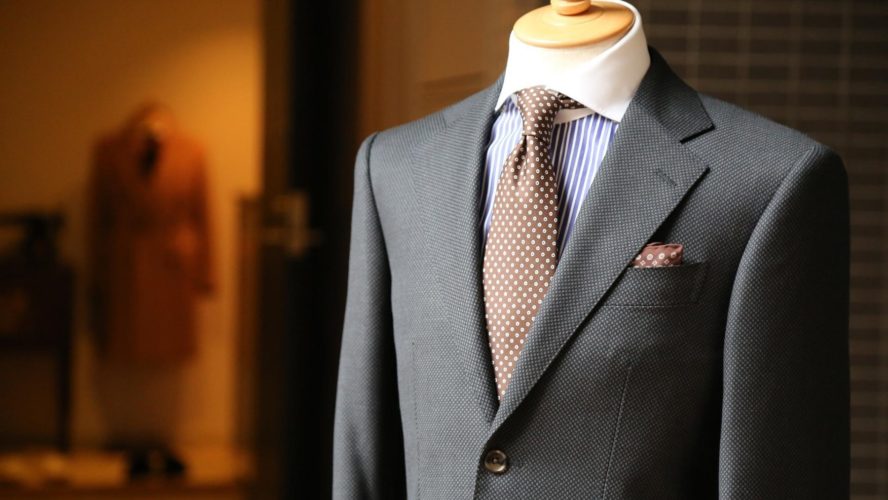By Bryan Ergle
Men’s suits are an intriguing animal… say ‘well dressed man’ and, regardless of what man comes to mind, odds are good that that man will be in a well-tailored suit. Yet many people today eschew them, not only in day-to-day life, but in business and work, as well. Some men only have one, if that, and, even then, only pull that one out for weddings, job interviews, and funerals – and even for those, it is sometimes questionable. I am going to challenge the perception that it is simply a ‘trend thing’ or a ‘comfort thing’, and it surely is not a ‘looking good’ thing. The phrase ‘a man in a well-tailored suit is to a woman, what a woman in lingerie is to a man’ is very much a thing.
No, the issue is one of quality and fit, as much or more so than it is one of norms. If you were to rewind back to the 1950’s, a gentleman in most any city in America could go to their local menswear store, which often had, or was run by, a tailor, and be fitted for a fine suit. This is all relatively speaking, of course; the finest gentlemen would go to a private tailor, likely on Saville Row in London, England, or Via Palestro in Milan, Italy, to have their suits handmade. Still the ones from their local tailor, which might have been considered semi-custom, were of good quality, and more importantly, the fit would have been excellent.
As time moved on, people wanted everything cheaper and easier, though, and as a consequence, more and more purchasing of menswear moved to department stores, where semi-custom was no longer feasible. Now it was moving toward what we have now – just finding the size that fit your chest and shoulders, and then the store would have it tailored for you, though back then, the tailoring was usually included, and more extensive – from the waist of the pants, the seat, the legs, cuffs, to the sleeves, jacket length, and sometimes even taking in or letting out the midsection of the jacket. The tailoring took time, expertise, and added cost, though, so, as you can imagine, as the push for fast and easy continued, these offerings began to thin.
As this inexorable march downward in fit happened, a parallel trajectory was being charted in quality. Manufacturing for suits, which had been made in the US, England, or Italy, were now being moved to Mexico, India, South America, or Asia, to effect massive cost savings for the manufacturers. The push moved from handmade to machine made, as machines, while not as high quality, were consistent and of ‘reasonably good quality’, and of course, were much cheaper than having a staff trained specialized suit makers. Glue started to be used instead of canvasing (a topic we’ll cover in more detail later), stitches started to be missed. Fabric choices became lamentable. Labels first became hidden, then misleading.
Eventually the oasis became a desert. Just yesterday, I went by the mall to check out the suits at department stores, and it was heartbreaking. Suits from Hugo Boss, considered by many to be a reputable name in fashion, had two-piece suits for $800-$1000 – which I would consider to be inexpensive for a suit – but a close look revealed the usual decline. The label inside the jacket is misleading… ‘Woven in Italy’. Ah, great, an Italian suit! No no… the fabric is from Italy. A closer look at the actual label, tucked away in a pocket, reveals that the suit was made in Croatia. All this, along with a myriad of other issues.
A well-known brand, Michael Kors, had suits for as little as $360 – the only brand-name suits available at the same department store where I had bought my Hickey Freeman suit years ago, if you want to know how tragically things have declined. The suit, made in India, was a 69% polyester fabric, blended with viscose. The buttons on the cuff didn’t even have the courtesy of fake stitched buttonholes. It seemed like something that might be made for an extra in a movie – one where they’re absolutely sure it will never, ever be seen up close.
The only relatively higher-end brand offered that I found was a selection of Canali suits, from Italy. Even there, I was left with the impression of ‘how the mighty have fallen’. The suits were about the price I’ve seen in the past, $1,900-$2,400, in this case, for a two-piece. Yet, even with these, I was seeing non-functional sleeve cuffs, and limited sizing. Indeed, a quick search on the stores website returned rather poor reviews for the suits I saw, coming in around two stars out of five. “Beautiful suit. I’m very disappointed in the fit. Not a true fit at all” says one. Others talk about not running true to size, jackets being very tight, etc etc. You get the picture.
It seems bleak… after all, why would you want to spend $2,400 on a two-piece suit with poor-to-middling reviews, that doesn’t fit that well? Many men don’t, and the menswear stores of the past, tailor on-hand, with fine options at decent prices, is non-existent anymore. We – as a society – drove them to extinction. And custom suits, everybody knows, are far more expensive than OTR. So a lot of men just don’t ‘do’ suits now, they prefer to save the money, if they’re not going to look good. But perhaps there is salvation… but not where you might be thinking.



